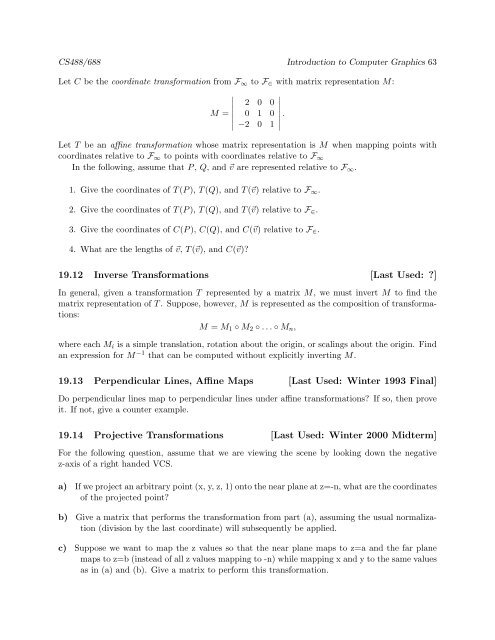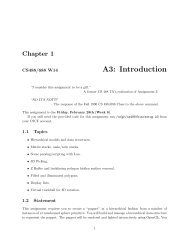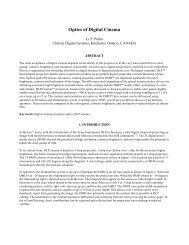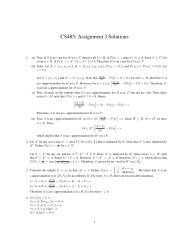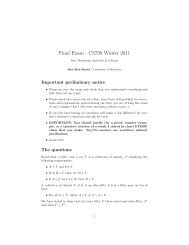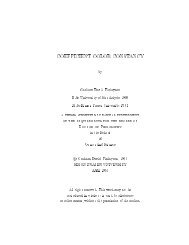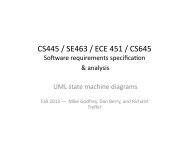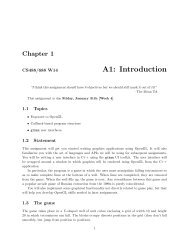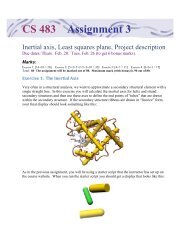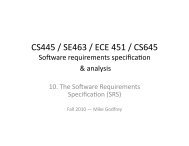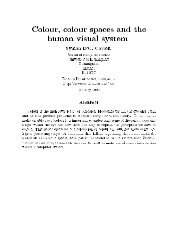Past Midterm and Exam Questions (PDF) - Student.cs.uwaterloo.ca ...
Past Midterm and Exam Questions (PDF) - Student.cs.uwaterloo.ca ...
Past Midterm and Exam Questions (PDF) - Student.cs.uwaterloo.ca ...
You also want an ePaper? Increase the reach of your titles
YUMPU automatically turns print PDFs into web optimized ePapers that Google loves.
CS488/688 Introduction to Computer Graphi<strong>cs</strong> 63<br />
Let C be the coordinate transformation from F ∞ to F ∈ with matrix representation M:<br />
M =<br />
∣<br />
2 0 0<br />
0 1 0<br />
−2 0 1<br />
Let T be an affine transformation whose matrix representation is M when mapping points with<br />
coordinates relative to F ∞ to points with coordinates relative to F ∞<br />
In the following, assume that P , Q, <strong>and</strong> ⃗v are represented relative to F ∞ .<br />
1. Give the coordinates of T (P ), T (Q), <strong>and</strong> T (⃗v) relative to F ∞ .<br />
2. Give the coordinates of T (P ), T (Q), <strong>and</strong> T (⃗v) relative to F ∈ .<br />
3. Give the coordinates of C(P ), C(Q), <strong>and</strong> C(⃗v) relative to F ∈ .<br />
4. What are the lengths of ⃗v, T (⃗v), <strong>and</strong> C(⃗v)?<br />
.<br />
∣<br />
19.12 Inverse Transformations [Last Used: ?]<br />
In general, given a transformation T represented by a matrix M, we must invert M to find the<br />
matrix representation of T . Suppose, however, M is represented as the composition of transformations:<br />
M = M 1 ◦ M 2 ◦ . . . ◦ M n ,<br />
where each M i is a simple translation, rotation about the origin, or s<strong>ca</strong>lings about the origin. Find<br />
an expression for M −1 that <strong>ca</strong>n be computed without explicitly inverting M.<br />
19.13 Perpendicular Lines, Affine Maps [Last Used: Winter 1993 Final]<br />
Do perpendicular lines map to perpendicular lines under affine transformations? If so, then prove<br />
it. If not, give a counter example.<br />
19.14 Projective Transformations [Last Used: Winter 2000 <strong>Midterm</strong>]<br />
For the following question, assume that we are viewing the scene by looking down the negative<br />
z-axis of a right h<strong>and</strong>ed VCS.<br />
a) If we project an arbitrary point (x, y, z, 1) onto the near plane at z=-n, what are the coordinates<br />
of the projected point?<br />
b) Give a matrix that performs the transformation from part (a), assuming the usual normalization<br />
(division by the last coordinate) will subsequently be applied.<br />
c) Suppose we want to map the z values so that the near plane maps to z=a <strong>and</strong> the far plane<br />
maps to z=b (instead of all z values mapping to -n) while mapping x <strong>and</strong> y to the same values<br />
as in (a) <strong>and</strong> (b). Give a matrix to perform this transformation.


